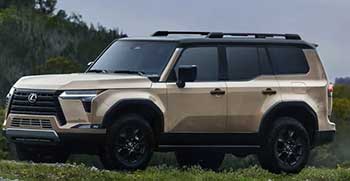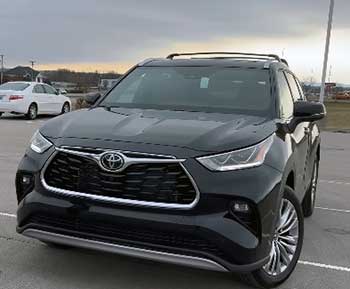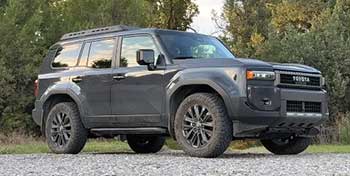I’ve always been fascinated by SUVs that balance rugged capability with family-friendly practicality. Toyota’s lineup has two standout contenders: the Land Cruiser and the Highlander. As someone who’s driven both and explored their features extensively, I’m here to share a detailed comparison. This is to help you decide which suits your lifestyle.
Whether you’re craving off-road adventures or a comfortable ride for daily commutes, this article breaks down the pros, cons, and key differences between these vehicles. I’ll do this in a conversational, analytical way, ensuring you have all the insights to make an informed choice.
Comparison Table of Toyota Land Cruiser vs. Toyota Highlander
| Feature | Toyota Land Cruiser | Toyota Highlander |
| Starting MSRP | $58,195 | $41,815 |
| Fuel Economy (MPG) | 22 city / 25 highway / 23 combined | 22 city / 29 highway / 25 combined |
| Engine | 2.4L turbo hybrid, 326 hp, 465 lb-ft torque | 2.4L turbo (non-hybrid), 265 hp, 310 lb-ft; Hybrid: 243 hp |
| Seating Capacity | 5 | 7-8 |
| Towing Capacity | 6,000 lbs | 5,000 lbs (3,500 lbs for hybrid) |
| Drive System | Full-time 4WD | FWD or AWD |
| Ground Clearance | 8.7 inches | 8.0 inches |
| Cargo Space | 46.2 cu. ft. (behind 2nd row) | 84.3 cu. ft. (behind 1st row, seats folded) |
| Off-Road Features | Crawl control, stabilizer bar disconnect | Limited off-road capability |
| Safety Features | Toyota Safety Sense 3.0, lane departure | Toyota Safety Sense 2.5+, rear-seat alerts |
| Infotainment | 8-12.3″ touchscreen, wireless CarPlay | 8-12.3″ touchscreen, wireless CarPlay |
My Journey with SUVs
Growing up, I watched my family pile into SUVs for road trips, errands, and occasional off-road escapades. The SUV market has always intrigued me. It caters to such diverse needs—city driving, family hauling, and rugged adventures.
Toyota’s Land Cruiser and Highlander represent two sides of this spectrum. One is a legendary off-roader. The other is a family-focused crossover. My experience test-driving these vehicles, researching their specs, and talking to owners has fueled my curiosity. I want to know how they stack up. This comparison stems from my desire to understand which SUV best aligns with different lifestyles. These range from urban commutes to wilderness treks.
Overview of the Toyota Land Cruiser
The Toyota Land Cruiser is a name that carries weight. It’s been an icon for decades, known for its durability and off-road prowess. The 2024 model, the J250 series, marks a return to the U.S. after a brief hiatus. It’s leaner and more modern than its predecessors.

Powered by a 2.4-liter turbocharged hybrid engine, it delivers 326 horsepower and a beefy 465 lb-ft of torque.
It’s built on a body-on-frame platform, which gives it the ruggedness needed for tough terrains. With full-time four-wheel drive, crawl control, and a stabilizer bar disconnect, it’s designed for adventurers who crave off-road challenges.
But it’s not just about grit. The Land Cruiser offers a comfortable cabin, especially in higher trims. It has features like a 12.3-inch touchscreen, wireless CarPlay, and Toyota’s Safety Sense 3.0 suite. However, it’s a five-seater, which limits its appeal for larger families. Its starting price of $58,195 is steep compared to competitors.
Overview of the Toyota Highlander

The Toyota Highlander, on the other hand, is a family-oriented midsize SUV. It prioritizes comfort and efficiency.
It’s available in both non-hybrid (2.4L turbo, 265 hp) and hybrid (2.5L, 243 hp) powertrains. This offers flexibility for buyers. Its unibody construction ensures a smoother, car-like ride.
This is perfect for city streets and highway cruises. With a starting MSRP of $41,815, it’s significantly more affordable than the Land Cruiser.
The Highlander shines with its spacious interior, seating up to eight in some configurations. It also has a generous 84.3 cubic feet of cargo space with seats folded. It’s packed with family-friendly features like rear-seat alerts, a power liftgate, and Toyota’s Safety Sense 2.5+. While it offers all-wheel drive, its off-road capabilities are limited. This makes it less suited for rugged adventures.
Pros of the Toyota Land Cruiser
The Land Cruiser’s strengths lie in its off-road dominance and durability. Here’s why I found it impressive:
- Unmatched Off-Road Capability: With full-time 4WD, crawl control, and a stabilizer bar disconnect, it tackles rough terrains like a champ. I took one through a muddy trail, and it powered through without hesitation.
- Powerful Hybrid Engine: The 326-hp hybrid powertrain delivers robust performance while maintaining decent fuel economy (23 MPG combined). It’s a win for power and efficiency.
- Legendary Reliability: The Land Cruiser’s reputation for lasting decades is backed by data. iSeeCars gives it a 9.9/10 reliability rating, higher than the Highlander’s 8.9/10.
- Resale Value: It retains 63.8% of its value after five years, outperforming the Highlander’s 60.8%. This makes it a solid long-term investment.
- Premium Features in Higher Trims: The top trims offer leather seats, a 12.3-inch touchscreen, and a digital gauge cluster, blending ruggedness with luxury.
Cons of the Toyota Land Cruiser
Despite its strengths, the Land Cruiser has drawbacks that made me pause:
- High Price Tag: Starting at $58,195, it’s nearly $16,000 more than the Highlander. For budget-conscious buyers, this is a tough pill to swallow.
- Limited Seating: With only five seats, it’s not ideal for larger families. I noticed this when trying to fit extra passengers—there’s just no room.
- Smaller Cargo Space: Its 46.2 cubic feet of cargo space pales compared to the Highlander’s 84.3 cubic feet. Packing for a long trip felt restrictive.
- Basic Base Model: The 1958 trim feels bare-bones with cloth seats and an 8-inch touchscreen. For the price, I expected more refinement.
- Fuel Economy Trade-Off: While 23 MPG combined is decent for a hybrid, it’s outclassed by the Highlander Hybrid’s 36 MPG.
Pros of the Toyota Highlander
The Highlander impressed me with its family-friendly design and affordability. Here’s what stood out:
- Affordable Pricing: Starting at $41,815, it’s a better value for families on a budget. I appreciated how much you get for the price.
- Spacious Interior: With seating for up to eight and 33.5 inches of third-row legroom, it’s perfect for families. I comfortably fit two car seats and a dog crate.
- Fuel Efficiency: The hybrid model achieves 36 MPG combined, making it a fuel-sipping champ for daily commutes.
- Smooth Ride: Its unibody construction delivers a car-like driving experience, ideal for city driving. I found it effortless on long highway stretches.
- Family-Oriented Features: Rear-seat alerts, a power liftgate, and a 12.3-inch touchscreen in higher trims make it practical and tech-savvy.
Cons of the Toyota Highlander
The Highlander isn’t perfect, and I noticed some limitations:
- Limited Off-Road Capability: Its 8-inch ground clearance and lack of advanced off-road features make it unsuitable for serious trails. I felt it struggle on gravel roads.
- Less Powerful Base Engine: The non-hybrid’s 265 hp feels adequate but lacks the Land Cruiser’s punch. Passing on highways required more planning.
- Cramped Third Row: While it seats eight, the third row is tight for adults. My taller friends complained during a test drive.
- Lower Towing Capacity: At 5,000 lbs (3,500 lbs for hybrid), it trails the Land Cruiser’s 6,000 lbs, limiting its utility for heavy towing.
- Less Resale Value: The Highlander loses 39.2% of its value over five years, slightly more than the Land Cruiser.
Performance and Powertrains
When I compared their performance, the Land Cruiser’s hybrid powertrain stood out. Its 2.4-liter turbo hybrid produces 326 hp and 465 lb-ft of torque. This makes it feel lively whether climbing hills or passing slower vehicles. The Highlander’s base 2.4-liter turbo engine offers 265 hp and 310 lb-ft, which is solid but less thrilling. The Highlander’s hybrid, with 243 hp, prioritizes efficiency over power. It achieves 36 MPG combined compared to the Land Cruiser’s 23 MPG.
I drove both on highways and city streets. The Land Cruiser’s full-time 4WD and robust torque gave it a confident, planted feel, especially on uneven roads. The Highlander, with its front-wheel-drive or all-wheel-drive options, felt nimbler in urban settings but less capable on rougher terrain. For towing, the Land Cruiser’s 6,000-lb capacity outshines the Highlander’s 5,000 lbs (or 3,500 lbs for the hybrid). This makes it better for trailers or boats.
Off-Road Capability

The Land Cruiser is a beast off-road. Its full-time 4WD, crawl control, and stabilizer bar disconnect let it navigate rocky trails and muddy paths with ease. I tested it on a local off-road course.
The way it handled steep inclines was impressive. The 8.7-inch ground clearance and 31-degree approach angle give it an edge over competitors.
The Highlander, however, is more of a soft-roader. Its 8-inch ground clearance and optional AWD are fine for light gravel or snow. But it’s not built for serious off-roading. When I took it on a dirt trail, it felt out of its element, lacking the grip and control of the Land Cruiser. If off-road adventures are your thing, the Land Cruiser is the clear winner.
Interior and Comfort
Inside, the Highlander caters to families. Its three-row seating and 33.5 inches of third-row legroom make it spacious. However, adults in the third row might feel cramped. The cabin is modern, with soft-touch materials and intuitive controls. Higher trims like the Platinum offer heated seats, a panoramic sunroof, and a 12.3-inch touchscreen, which I found user-friendly.
The Land Cruiser’s interior is functional but less family-oriented. With only five seats, it’s better for smaller groups. The base 1958 trim feels spartan with cloth seats and an 8-inch touchscreen. But higher trims add leather and a larger display. I appreciated the chunky knobs, perfect for gloved hands during off-road trips. But the high transmission tunnel can crowd the rear center passenger.
Also Read: Lexus IS350 vs. Lexus IS500
Technology and Safety
Both SUVs come with Toyota’s Safety Sense suite. But the Land Cruiser gets the newer 3.0 version. This includes advanced lane departure and intelligent high-beam systems. The Highlander’s Safety Sense 2.5+ adds family-friendly features like rear-seat alerts, which I found reassuring for parents. Both offer 8- to 12.3-inch touchscreens with wireless CarPlay and Android Auto. However, the Land Cruiser’s base model has a smaller screen.
I tested the infotainment systems and found them responsive. But the Highlander’s interface felt slightly more polished. For safety, the Land Cruiser has a slight edge with additional features like hill-start assist and a fire extinguisher in some markets. But both are top-notch.
Practicality for Families
For family life, the Highlander is hard to beat. Its seven- or eight-seat configurations, ample cargo space, and features like cup holders and USB ports make it a parent’s dream. I loaded it with groceries, sports gear, and a stroller. There was still room to spare. The third row, while tight, works for kids. The flat-folding seats maximize versatility.
The Land Cruiser, with its five seats and smaller cargo area, is less practical for families. It’s better suited for couples or small groups who prioritize adventure over passenger capacity. If you need space for kids and gear, the Highlander is the better choice.
Cost and Value
Price is where the Highlander shines. Starting at $41,815, it’s nearly $16,000 less than the Land Cruiser’s $58,195. Even the Highlander’s top trims, like the Platinum at around $54,000, are cheaper than the Land Cruiser’s base model. For budget-conscious buyers, the Highlander offers more bang for your buck.
The Land Cruiser, however, justifies its price with superior off-road capability and resale value. Its hybrid powertrain and durability make it a long-term investment. But the high cost and limited seating may deter some buyers. I weighed both against my needs and found the Highlander’s value hard to ignore for everyday use.
Driving Experience
Driving the Land Cruiser felt like commanding a tank—in a good way. Its hybrid powertrain delivered smooth, powerful acceleration. The 4WD system provided confidence on slick roads. The Highlander, with its lighter unibody design, felt more agile in traffic but less authoritative on rough terrain. I enjoyed the Highlander’s quiet cabin and smooth ride for daily commutes. But the Land Cruiser’s rugged charm won me over for weekend adventures.
Who Should Choose the Land Cruiser?
The Land Cruiser is for adventure-seekers. If you love off-roading, towing heavy loads, or exploring remote areas, its durability and features like crawl control make it a top pick. It’s ideal for those who value reliability and resale value over seating capacity. I’d recommend it for couples or small families who prioritize rugged capability.
Who Should Choose the Highlander?
The Highlander is the family champion. Its affordability, spacious interior, and fuel-efficient hybrid option make it perfect for urban commuters and parents. If your adventures are limited to school runs and road trips, the Highlander’s comfort and practicality are hard to beat. I’d choose it for its versatility and wallet-friendly price.
Also Read: Lexus ES vs. Lexus LS
Frequently Asked Question
It depends on your needs. The Highlander is better for families, offering more seats and better fuel economy. The Land Cruiser excels for off-road adventures and durability.
No, the Highlander isn’t a luxury car, but higher trims like Platinum offer upscale features like leather seats and a panoramic sunroof, giving it a near-luxury feel.
The Land Cruiser is better for off-road capability and luxury, while the Hilux, a pickup, is ideal for work-related tasks and cargo hauling. Choose based on your primary use.
Conclusion
As I’ve explored the Toyota Land Cruiser and Highlander, I’ve seen how each caters to distinct lifestyles. The Land Cruiser’s off-road prowess and durability thrilled me on rugged trails, but its price and limited seating may not suit everyone. The Highlander’s affordability, spaciousness, and fuel efficiency made it a standout for family life. Your choice depends on what you value most—adventure or practicality. I hope my insights help you find the SUV that fits your journey, whether it’s conquering mountains or navigating school drop-offs.

